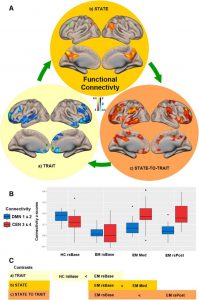Improve Body Awareness with Mindfulness
By John M. de Castro, Ph.D.
“We are so caught up in thought, distracted by everyday life and media, or simply in a hurry that we hardly feel anything anymore. Our life often only takes place in the head. But we are so much more! It is also very nourishing and beneficial to gradually develop a sense of appreciation and gratitude for the incredible performance that our body provides on a daily basis. Breathing, walking, eating and digesting, talking, hugging children, – let alone the five senses.” – Being mindful
Most of us spend the majority of our lives lost in thought. Even when we become aware of our surroundings it is principally of the sights and sounds surrounding us. It is usually only when something is very wrong that we become aware of our bodies, what is called interoceptive awareness. We are generally unaware of the signals from our bodies such as the breath, movements in the GI tract, heart beats accompanied with surges in blood pressure, the sensations from our muscles and joints, even the sensations from our skin.
Body awareness can be a good indicator of stress and emotional state. The lack of body awareness can be a real problem as this interoceptive awareness is needed to regulate and respond appropriately to the emotions. Being aware of the state of our bodies is also important for maintaining health, both for recognizing our physical state and also for making appropriate decisions about health-related behaviors. Interoceptive awareness is even fundamental to our sense of self and world view. Most contemplative practices focus attention on our internal state and thus improve our body awareness. There is a need to review and summarize what has been learned about the ability of mindfulness to improve body awareness.
In today’s Research News article “The relationship between mindfulness and objective measures of body awareness: A meta-analysis.” (See summary below or view the full text of the study at: https://www.ncbi.nlm.nih.gov/pmc/articles/PMC6874545/), Treves and colleagues review, summarize, and perform a meta-analysis of the published research literature on the effects of mindfulness on body awareness. They identified 15 published studies involving a total of 879 participants. Seven studies were randomized controlled trials (RCTs) while 8 were comparisons of long-term meditators to meditation naïve controls.
They found that overall the published research literature reports that there is a small but significant positive relationship between mindfulness and body awareness such that the higher the levels of mindfulness the higher the levels of body awareness. This relationship was only significant with the randomized controlled trials.
These findings are suggestive that mindfulness training produces a small but significantly greater sensitivity to bodily states. But these findings must be interpreted cautiously as the effect sizes were very small and only present in manipulative studies (RCTs). The fact that the relationship was only present for RCTs and not when long-term meditators were compared to meditation naïve participants suggests that something about the experimental procedure is critical in producing the effect. This may be contaminants such as participant or experimenter biases, demand characteristics, or sensitization effects. It may also suggest that short-term meditation practice increases sensitivity that habituates over time.
So, improve body awareness with mindfulness.
“With the mind in the body, we can regulate our responses to events, people, and situations, set up an early warning process to detect fight, flight, and freeze while making better, more conscious choices, notice muscular tension and release it within minutes, observe which areas of the body are habitually tight, tense, and need extra relaxation effort, be more aware of signs of tension or perceived danger in others and adjust our responses skillfully.” – Elad Levinson
CMCS – Center for Mindfulness and Contemplative Studies
This and other Contemplative Studies posts are also available on Google+ https://plus.google.com/106784388191201299496/posts and on Twitter @MindfulResearch
Study Summary
Treves, I. N., Tello, L. Y., Davidson, R. J., & Goldberg, S. B. (2019). The relationship between mindfulness and objective measures of body awareness: A meta-analysis. Scientific reports, 9(1), 17386. doi:10.1038/s41598-019-53978-6
Abstract
Although awareness of bodily sensations is a common mindfulness meditation technique, studies assessing the relationship between mindfulness and body awareness have provided mixed results. The current study sought to meta-analytically examine the relationship between mindfulness operationalized as a dispositional trait or a construct trained through short- (i.e., randomized controlled trials [RCTs]) or long-term mindfulness meditation practice with objective measures of body awareness accuracy. PubMed, Web of Science, PsycINFO, and Scopus were searched. Studies were eligible if they reported the association between mindfulness and body awareness, were published in English, and included adults. Across 15 studies (17 independent samples), a small effect was found linking mindfulness with greater body awareness accuracy (g = 0.21 [0.08, 0.34], N = 879). When separated by study design, only RCTs continued to show a significant relationship (g = 0.20, [0.02, 0.38], k = 7, n = 505). Heterogeneity of effects was low (I2 < 25%), although with wide confidence intervals. Effects were not moderated by study quality. Low fail-safe N estimates reduce confidence in the observed effects. Results suggest a small but potentially detectable relationship between mindfulness and body awareness accuracy. Future investigations could examine individual differences in body awareness as a mechanism within mindfulness interventions.
https://www.ncbi.nlm.nih.gov/pmc/articles/PMC6874545/









